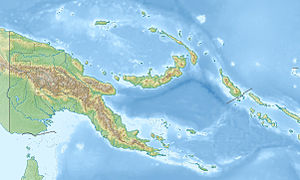Kiwai (Insel)
Kiwai ist eine Binneninsel und die größte Insel im Delta des Flusses Fly, Papua-Neuguinea. Sie ist 59 km lang vom Dorf Sepe an der Nordspitze bis zum Dorf Samari an der Südspitze, bis zu neun Kilometer breit, hat einen Umfang von 135,3 km und eine Fläche von 359,1 km².[1] Eine sprachliche Studie gab eine Bevölkerung von 4500 für die Insel an,[2] die Volkszählung 2000 wies jedoch nur 2092 Einwohner nach.[3] Die benachbarten Inseln Purutu und Wabuda gehören ebenfalls zu den drei größten Inseln im Fly-Flussdelta.
| Kiwai
| ||
|---|---|---|
 | ||
| Gewässer | Fly River | |
| Inselgruppe | Fly River Delta Islands | |
| Geographische Lage | 8° 33′ S, 143° 25′ O | |
|
| ||
| Länge | 59 km | |
| Breite | 9 km | |
| Fläche | 359,1 km² | |
| Höchste Erhebung | 9 m | |
| Einwohner | 2092 (2000) 5,8 Einw./km² | |
| Hauptort | Iasa | |
 | ||
Kiwai teilt denn Fluss in einen Nordarm und einen Südarm. Die Insel ist stark bewaldet liegt nur wenige Meter über dem Meeresspiegel.
Die Bewohner des Flussdeltas (darunter die Kiwai) leben von Landwirtschaft und Jagd. Kokosnusspalmen, Brotfruchtbäume, Gemüsebananen, Sagopalmen und Zuckerrohr werden kultiviert.[4]
Verwaltungsmäßig gehört die Insel zur Kiwai Rural LLG (Local Level Government area) des South Fly Districts in der Western Province.
Zur Volkszählung 2000 verteilte sich die Bevölkerung von 2092 auf elf Dörfer (ein zwölftes Dorf war unbewohnt) und zwei separate Einrichtungen entlang der Küste:
![]() Karte mit allen Koordinaten: OSM | WikiMap
Karte mit allen Koordinaten: OSM | WikiMap
| Census Unit Number |
Name | Ward | Haushalte | Bevölkerung männlich |
Bevölkerung weiblich |
Bevölkerung insgesamt |
Koordinaten |
|---|---|---|---|---|---|---|---|
| 002 | Agobaro | 11 Sagasia | 22 | 62 | 63 | 125 | 8,6328° S, 143,6153° O |
| 009 | Ipisia | 11 Sagasia | 22 | 83 | 73 | 156 | 8,6349° S, 143,6275° O |
| 016 | Sagasia | 11 Sagasia | 21 | 89 | 78 | 167 | 8,6142° S, 143,5788° O |
| 023 | Wapaura | 11 Sagasia | 0 | 0 | 0 | 0 | 8,5757° S, 143,5341° O |
| 020 | Sepe | 17 Sepe | 17 | 56 | 48 | 104 | 8,4099° S, 143,1947° O |
| 030 | Auti | 17 Sepe | 18 | 60 | 63 | 123 | 8,4598° S, 143,2269° O |
| 008 | Iasa | 18 Samari | 28 | 103 | 121 | 224 | 8,6255° S, 143,5041° O |
| 015 | Oromosapuo | 18 Samari | 27 | 103 | 105 | 208 | 8,6488° S, 143,6386° O |
| 018 | Samari | 18 Samari | 38 | 143 | 159 | 302 | 8,7007° S, 143,6153° O |
| 019 | Samari Community School | 18 Samari | 3 | 9 | 15 | 24 | 8,712° S, 143,6266° O |
| 020 | Samari Health Centre | 18 Samari | 1 | 4 | 0 | 4 | 8,712° S, 143,6148° O |
| 027 | Saguane | 18 Samari | 1 | 4 | 2 | 6 | 8,6623° S, 143,5882° O |
| 012 | Kubira | 23 U'Uwo | 35 | 107 | 113 | 220 | 8,5397° S, 143,3709° O |
| 022 | U'Uwo | 23 U'Uwo | 36 | 223 | 206 | 429 | 8,4704° S, 143,3229° O |
Das größte Dorf, Uʻuwo mit 429 Einwohnern, liegt an der Nordküste. Das zweitgrößte Dorf, Samari, liegt an der Südspitze der Insel.
Einzelnachweise
BearbeitenLiteratur
Bearbeiten- James Chalmers: Notes on the Natives of Kiwai Island, Fly River, British New Guinea. The Journal of the Anthropological Institute of Great Britain and Ireland, Vol. 33, (Jan. - Jun., 1903), S. 117–124
- Alfred C. Haddon: Reports of the Cambridge Anthropological Expedition to Torres Straits. Vol. 1 General Ethnography (1935), S. 210–236 (The Kiwaians)
- Gunnar Landtman: The Kiwai Papuans of British New Guinea; a nature-born Instance of Rousseau's ideal Community, Macmillan and Co (London, 1927)
